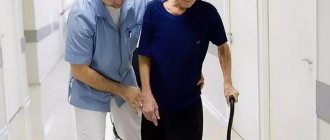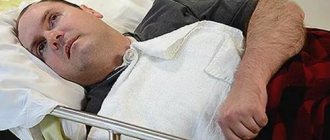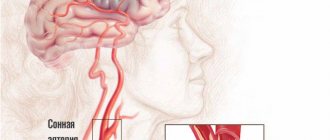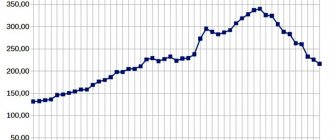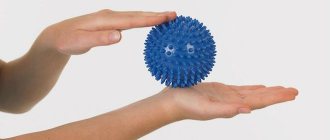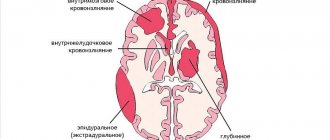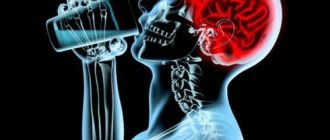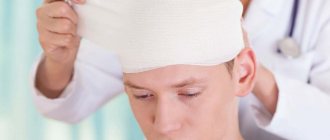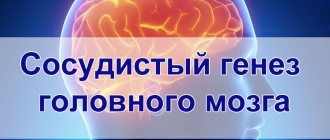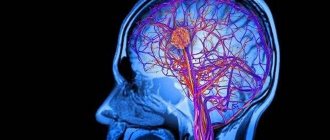Cerebellar stroke is one of the most dangerous pathologies associated with impaired cerebral blood supply. The prognosis for the development of this disease is unfavorable, especially if the damage affects the adjacent part - the brain stem.
To preserve the life and health of the victim, accurate diagnosis and prompt treatment are required.
Ischemic stroke: what is it?
An ischemic stroke occurs when there is an obstruction in the blood vessels supplying blood to the brain.
The main condition for this type of obstruction is the development of fatty deposits lining the walls of the vessel. This is called atherosclerosis. The definition of the nosological form of the disease is based on three independent pathologies that characterize local circulatory disorders, designated by the terms “Ischemia”, “Infarction”, “Stroke”:
- ischemia is a deficiency of blood supply in a local area of an organ or tissue.
- A stroke is a disruption of blood flow in the brain due to rupture/ischemia of one of the vessels, accompanied by the death of brain tissue.
With ischemic stroke, symptoms depend on the type of disease:
- Atherothrombotic attack - occurs due to atherosclerosis of a large or medium-sized artery, develops gradually, most often occurs during sleep;
- Lacunar - diabetes mellitus or hypertension can cause circulatory problems in small-diameter arteries.
- Cardioembolic form - develops as a result of partial or complete blockage of the middle artery of the brain by an embolus, occurs suddenly during wakefulness, subsequently embolisms may occur in other organs;
- Ischemic, associated with rare causes - dissection of the arterial wall, excessive blood clotting, vascular pathologies (non-atherosclerotic), hematological diseases.
- Of unknown origin – characterized by the impossibility of determining the exact causes of occurrence or the presence of several causes;
From all of the above, we can conclude that the answer to the question “what is an ischemic stroke” is simple - a violation of blood circulation in one of the areas of the brain due to its blockage with a blood clot or cholesterol plaque.
There are five main periods of completed ischemic stroke:
- The most acute period is the first three days;
- Acute period – up to 28 days;
- Early recovery period – up to six months;
- Late recovery period – up to two years;
- The period of residual effects is after two years.
Most ischemic cerebral strokes begin suddenly, progress quickly, and result in death of brain tissue within minutes to hours.
Based on the area of damage, cerebral infarction is divided into:
- Ischemic stroke on the right side – the consequences mainly affect motor functions, which are subsequently poorly restored, psycho-emotional indicators may be close to normal;
- Ischemic stroke on the left side - the consequences are mainly the psycho-emotional sphere and speech, motor functions are restored almost completely;
- Cerebellar – coordination of movements is impaired;
- Extensive - occurs when there is a complete absence of blood circulation in a large area of the brain, causes swelling, and most often leads to complete paralysis with the inability to recover.
Pathology most often occurs in people of old age, but can happen at any other age. The prognosis for life is individual in each case.
Forecast
With extensive damage to the cerebellum during a stroke, associated with the development of edema and displacement of its parts, up to 80% of patients die. For the most part, they are diagnosed with a hemorrhagic stroke, a rapid transition to a coma. Death usually occurs within 7 days from the date of impact.
Attention. Emergency surgery helps save up to 60% of patients.
The patient’s condition after the acute period often worsens due to associated pneumonia, thrombosis of the blood vessels of the lungs, and disruption of the heart. The combination of these pathologies with circulatory disorders often causes an unfavorable prognosis.
First aid and diagnostics
Before doctors arrive, first aid must be provided. Often, when signs of a stroke appear, patients experience extreme stress.
First aid:
- It is necessary to reassure the patient if possible, since strong anxiety can aggravate the situation.
- The person should be placed on a flat horizontal surface and his shoulders should be straightened.
- You need to put a small pillow or blanket under your head.
- It is necessary to turn the patient's head to the side so that if vomiting occurs, the masses do not enter the lungs.
- If necessary, the patient should be given a painkiller tablet.
- If a person has high blood pressure, an antihypertensive drug may be used.
- Be sure to loosen your belt and unbutton the top buttons of your shirt.
- It is advisable to open the window to provide fresh air into the room.
Doctors begin diagnosing the patient’s condition immediately after arrival. Anamnesis is collected from people who were present at the onset of the attack, and vital signs are assessed, including measuring blood pressure, determining blood gases, etc. After admission to the hospital, the patient is examined by a neurologist and a number of other highly specialized specialists. Physiological tests are required.
During the diagnostic process, the following studies are prescribed:
- general and biochemical blood tests;
- angiography;
- CT;
- MRI;
- ECG;
- Doppler ultrasound.
After all the necessary examinations and assessment of the patient’s condition, comprehensive treatment can be prescribed.
Selection of treatment regimen
Cerebellar stroke therapy is carried out in a hospital setting. First, resuscitation measures are carried out. During this period, therapy can be carried out using both conservative and surgical methods.
In the ischemic form of stroke, blood thinners are first selected.
For the hemorrhagic form of the pathology, medications that promote thrombus formation are prescribed.
The treatment regimen includes medications that help stabilize blood pressure. Drugs that have antiepileptic and anticonvulsant effects are often prescribed. If necessary, tranquilizers and sedatives are introduced into the treatment regimen.
Non-steroidal anti-inflammatory drugs are prescribed to eliminate signs of fever. Analgesics are used to relieve pain. To reduce the risk of developing cerebral edema, diuretics are prescribed. Additionally, medications are introduced into the treatment regimen to eliminate the patient’s symptomatic manifestations of stroke.
Therapy may also require surgery. In case of ischemic stroke, surgery can be performed to increase the lumen of the vessel bed or remove the formed thrombus. In addition, it may be necessary to create an additional vessel to redirect blood flow.
In case of hemorrhagic stroke of the cerebellum, surgical intervention is often performed to eliminate the hematoma and restore the integrity of the damaged vessel.
Prevention
As you know, it is much easier to prevent any disease than to treat it later. A stroke in this case is no exception. If a person is at risk or has previously suffered a pathology, he needs to adhere to certain rules:
- undergo a full medical examination every six months, including brain tomography;
- carefully monitor cholesterol levels, eliminate the amount of smoked and fatty foods consumed, foods high in sugar and salt;
- get rid of bad habits such as drinking alcohol and smoking;
- sport is an integral part of every person’s life. Try to do some exercises every day, do gymnastics, jog, etc.;
- avoid stressful situations.
As you already understood from our material, one of the most terrible pathologies is cerebellar stroke. Life expectancy prognosis varies depending on many factors. You need to remember that if the first signs of problems with blood circulation occur, you should consult a doctor as soon as possible. You can avoid a stroke only if you take care of your health and undergo timely routine examinations.
First aid and treatment
If you suspect a stroke, you should call an ambulance. Before the doctors arrive, the patient is placed on a bed and given symptomatic treatment. Headaches are relieved with analgesics, and spasms are treated with relaxants. If the patient is unconscious or unable to swallow, intravenous solutions are used instead of tablets. It is advisable that the selection and administration of drugs be carried out by a person with a medical education.
The ambulance team examines the patient and listens to complaints. First aid can be aimed at:
- decreased blood clotting;
- blood clot destruction;
- elimination of external bleeding.
Ischemic stroke of the cerebellum requires the use of the following groups of drugs:
- thrombolytics - destroy existing blood clots and prevent the formation of new blood clots;
- medications that improve heart function;
- medications to normalize blood pressure.
If the cause of the stroke is hemorrhage in the cerebellum, the following drugs are prescribed:
- drugs to stop bleeding;
- medications to maintain normal blood pressure levels;
- neuroprotectors - to restore normal functioning of nerve cells.
If drug therapy is ineffective, the patient is admitted to the hospital for surgery. In case of hemorrhagic stroke, craniotomy is performed, bleeding is stopped, and a plug is installed in the aneurysm. In case of ischemic damage to the cerebellum, the following measures are taken:
- redirection of blood flow;
- removal of blood clots;
- endarterectomy of arteries;
- stenting, angioplasty (allows you to expand the lumen of the artery).
After the operation, the patient is admitted to the intensive care unit, where he undergoes further treatment. In this case, drugs are administered that stimulate the heart and normalize blood pressure. When the patient’s well-being improves, he is transferred to the general therapy department to undergo symptomatic treatment and rehabilitation. The following techniques help restore lost functions: acupuncture, reflexology, manual therapy, massage, physical therapy, classes with a psychologist and speech therapist, diet, etc.
Classification by affected area
Isolated and extensive strokes are classified depending on how wide the area covered by necrosis or hematoma is.
Isolated stroke
Occurs as a result of a decrease or cessation of blood flow in one artery to the left or right hemisphere of the cerebellum.
Depending on the type of artery, characteristic signs of pathology are noted:
- Posterior inferior cerebellar artery. The main symptomatology is disorders of the vestibular apparatus. Patients suffer from constant dizziness, attacks of nausea, and pain in the back of the head.
- Anterior inferior artery. Some symptoms correspond to the first case: coordination and orientation in space are impaired, patients have slurred speech or “chanting” - pronouncing words syllable by syllable. Hearing impairment is noted as a specific symptom. Depending on which hemisphere the lesion is concentrated in, hearing loss or deterioration is observed on the right or left.
- Superior cerebellar artery. Balance disorders predominate: the patient cannot perform movements that require precision, and a “sailor’s gait” occurs - characteristic swaying from side to side when walking.
Major stroke
A process affecting large areas of the left or right hemispheres of the cerebellum can threaten the life of the patient. Most often it develops in the area of the superior or posterior inferior arteries with simultaneous cessation of blood flow through the vertebral artery. In this case, manifestations arise that are similar in symptoms to cerebral and brainstem strokes.
In most cases, the acute onset of the disease predominates. The patient experiences severe headaches, nausea, and motor dysfunction. If the lesion has spread to the brain stem, the breathing process is disrupted.
If a third or more of the cerebellum is damaged, the area of necrosis begins to swell greatly - the pathology becomes malignant.
In case of hemorrhages, the greatest risk is the accumulation of blood clots in the cranial fossa; acute dropsy develops, compression of the brain stem occurs and, as a result, coma and death of the patient.
No home methods, folk remedies, as well as conservative therapy will help in this situation - in 90% of cases death occurs. An urgent neurosurgical operation can save a patient with an acute form of extensive cerebellar stroke. But emergency surgery does not provide a 100% guarantee - a third of patients die.
With extensive strokes, there may be cases where the structures of the “big brain” are affected, and necrosis covers large areas of the cerebellum. Temporary improvement and a state of stability are replaced by a new increase in signs of the disease. Body temperature rises to critical levels, and the risk of coma increases many times over.
How it manifests itself
The manifestations of a stroke depend on its size. An isolated stroke is characterized by certain signs, while a large stroke is characterized by others.
Symptoms of an isolated stroke:
- vestibular disorders (including dizziness);
- nausea;
- pain in the back of the head;
- impaired coordination of movements;
- speech and hearing disorders;
- violation of fine motor skills.
An extensive cerebellar infarction develops rapidly, with general cerebral symptoms predominant (nausea, headaches, vomiting), impaired coordination of movements and fine motor skills, and problems with speech. There may also be disturbances in cardiac activity and respiratory function due to damage to the brain stem.
If more than 1/3 of the volume of the cerebellar hemispheres is damaged, the affected tissue increases in size. The result is compression of the cerebrospinal fluid circulation pathways, the development of acute hydrocephalus, compression of the brain stem and death.
Even minor hemorrhage in the cerebellum is life-threatening, so when the first signs of the disease appear, you should consult a doctor.
Important information: How long do they live after a repeated (secondary) stroke and what are its consequences in men?
Consequences
A brain stem stroke is dangerous not only due to death, but also to a large percentage of patients’ disability. Often people who have had an attack cannot walk or even sit on their own. Their speech is impaired and they become completely dependent on the people caring for them. In addition, patients may experience a second attack at any time or develop dangerous complications. With this course of the disease, patients most often die.
The most common cause of death after a stroke is swelling of the brain stem. The resulting hematoma infringes on the trunk, and as a result, cardiac or respiratory arrest occurs. This complication develops in the first days after the attack.
In a later period, the patient may develop complications such as:
- Pneumonia.
- Vein blockage.
- Infectious diseases of the kidneys and urinary tract.
- Internal bleeding.
- Heart attack.
These are only those complications that can lead to the death of the patient, but there are others that significantly complicate patient care and bring the patient a lot of suffering, among them:
- Bedsores.
- Difficulty swallowing.
- Psycho-emotional disorders.
Those patients who can ambulate a little are often injured as a result of falls. Caring for post-stroke patients requires special patience from relatives. Treatment can last for years and often does not bring the desired results.
Signs
The human brain contains approximately 100 billion neurons. It contains arachnoid, vascular, hard membranes covering the spinal cord and brain, gray and white matter. The brain consists of the medulla oblongata, posterior (including the pons and cerebellum), intermediate, large, and middle sections. They are all interconnected and perform specific functions.
Poor blood circulation in the brain, the symptoms of which are not clearly expressed in the initial stage, leads to an imbalance in the well-functioning functioning of the organ and focal death of neurons.
The main symptoms of the disease include:
- Headache (cephalgia), which only goes away after taking painkillers. Attacks tend to increase pain. A person with cephalgia does not always consult a doctor. If the cause of pain lies in impaired cerebral circulation, ignoring regular attacks leads to serious consequences.
- Pain in the eyes, which increases when trying to concentrate or rotate the eyeballs. A particularly unpleasant symptom manifests itself at the end of the day, when the eyes are overworked from prolonged strain.
- Dizziness, indicating not only circulatory pathologies, but also a number of many diseases - anemia, inflammation of the middle ear, the development of malignant and benign tumors. If attacks of whirling occur more than three times a month, you should see a therapist or neurologist.
- Nausea. Impaired circulatory function in the brain causes unbearable nausea. When it is accompanied by vomiting and attacks of dizziness not caused by intestinal poisoning, these are ominous signs of a stroke.
- Ringing noise, humming, buzzing in the ears are obvious symptoms of poor blood circulation. The more pronounced they are, the more serious the disease.
- Psycho-emotional disorders. There is lethargy, confusion, numbness of the limbs, and convulsions.
During cerebral attacks, the temperature rises, blood pressure rises, palms, forehead, and armpits sweat. The patient feels aches, weakness, and discomfort throughout the body.
The doctor can determine in which hemisphere the cerebral circulatory disorder occurred based on neurological symptoms. If the disorder occurs in both hemispheres, sensitivity of the limbs or individual parts of the body is lost. There are complaints of numbness of the face and skin.
With pathologies of the brain stem, the head begins to spin, the eyelids twitch, and the sensitivity and mobility of the tongue are lost. There is an insurmountable weakness in the limbs, and the swallowing process becomes more difficult.
Causes and factors of cerebellar stroke
The ischemic type of cerebellar stroke is usually considered the outcome of atherosclerotic disease. The thrombus travels through the vertebral or basilar artery through the bloodstream. Embolism can also occur with fresh myocardial infarction or atrial fibrillation. Surgical interventions on the neck are very dangerous, since during their implementation it is possible to traumatize the vertebral arteries with further disruption of blood flow.
The main causes of hemorrhagic stroke of the cerebellum:
- high blood pressure or sudden changes;
- cerebral amyloid angiopathy - deposition of amyloid in small blood vessels through which blood enters the central nervous system;
- taking antithrombotic drugs (“blood thinners”);
- neoplasms;
- inflammatory diseases of the walls of blood vessels.
Wrong lifestyle
In addition to the immediate causes, risk factors play a significant role in the development of cerebellar stroke. One of the key ones is the wrong lifestyle. It includes:
- low mobility during the day;
- food based on foods high in fat and sodium;
- smoking, alcohol abuse, taking narcotic drugs;
- constant nervous tension, chronic stress.
These factors contribute to disruption of normal blood circulation in organs, including the nervous system.
Diseases and medications
Diseases of the internal organs can provoke a cerebellar stroke. The relationship between cerebral circulatory disorders and the following somatic diseases has been proven:
- arterial hypertension;
- metabolic syndrome, accompanied by high levels of cholesterol and low-density lipoproteins in the blood;
- diabetes mellitus and other endocrine pathologies;
- cardiac ischemia;
- diseases in which blood clotting increases.
Uncontrolled use of medications that affect the functioning of the heart, change hormonal levels, and thin the blood can also cause acute impairment of cerebral circulation (including in the cerebellum).
Other reasons
Other causes of vascular accident include genetic predisposition and age factor. A number of genes are currently being studied that are potentially associated with an increased risk of cerebral circulatory disorders.
Restoring lost functions
Rehabilitation after a stroke begins immediately when the patient’s condition is stabilized and complications are excluded.
Recovery activities include:
- medications (cerebroprotectors, nootropics);
physiotherapy;- massage;
- Exercise therapy, including special training equipment;
- course of psychotherapy;
- training speech, memory, intelligence;
- hypocholesterol diet.
It is advisable for recovery to take place in special institutions and sanatoriums under the guidance of experienced specialists.
Causes and risk factors
Hemorrhagic or ischemic stroke of the cerebellum is a consequence of problems existing in the body. The following risk factors can lead to the development of this pathology:
- Hypertension.
- High sugar.
- High cholesterol.
- Atherosclerosis.
- Heart diseases.
- Metabolic disorders.
- Previous heart attacks and strokes.
- Coagulation disorder.
- Bad habits.
- Obesity.
- Sedentary lifestyle.
- Stress.
- Poor nutrition.
- Taking hormonal drugs.
A special risk group includes men over 60 years of age with the problems described above. In order to significantly reduce the risk of stroke, you need to carefully monitor your health. If you feel unwell, you should consult a doctor. It is worth noting that the most common cause of death in ischemic cerebellar stroke is late diagnosis. The patient may only experience dizziness or headaches and not see a doctor.
At-risk groups
Medical experts say that certain people are at higher risk of cerebellar stroke. In addition, there are risk factors. The latter, in turn, are divided into independent ones (which cannot be influenced) and those that can be overcome.
The first option includes the following circumstances:
- the presence of a heart attack or serious abnormalities in blood circulation;
- too thick blood;
- hereditary predisposition;
- older men.
There are also factors that can be easily eliminated, and then the likelihood of a stroke will be significantly reduced. These include:
- excessive consumption of alcoholic beverages in large quantities and with relative consistency;
- high blood pressure, problems with normalizing heart rhythm, high cholesterol;
- taking hormonal drugs for a long time, including contraceptives;
- overweight, metabolic disorders, poor diet, the presence of large amounts of foods high in salt, sedentary lifestyle, sedentary work.
About the disease
With this pathology, hemorrhage occurs in the cerebellum.
It is very difficult to predict such a stroke.
It happens, for the most part, suddenly and occurs within 2-3 minutes.
During this time, a person risks getting the following complications:
- Partial damage to motor abilities;
- Possibility of complete paralysis;
- The patient falls into a coma;
- If the case is severe, then the person dies.
Pathology is divided into ischemic and hemorrhagic types.
The cerebellum performs important functions in the body. Despite its small size, only 10% of the volume of the entire brain of the head, it ensures clear coordination of all human processes, controls the musculoskeletal system, and helps maintain muscle tone. Cerebellar stroke is dangerous because all of the above functions are disrupted.
Complications after a stroke
If the threatening condition is already over, doctors try not only to maintain life with drugs, but also to minimize the consequences of stroke. The cerebellum is an extremely important functional element. If a hemorrhage occurs and the brain tissue begins to swell, squeezing the cerebellum, then the following functions will be affected first:
- coordination of movements;
- regulation of body balance;
- muscle tone;
- coordination of actions of antagonist muscles.
As a result of ischemia, ataxia may develop, the type of which depends on the location of the lesion. If the cerebellar vermis is affected, static-locomotor ataxia develops. With this disorder, walking is affected, and patients cannot stand independently. If the cerebellar hemispheres are affected, then in this case they speak of dynamic ataxia. In this case, voluntary movements of the limbs are impaired.
Traditionally, when the cerebellar area is damaged, muscle tone decreases and problems with speech appear. Patients begin to speak much more slowly, draw out their words, and sometimes their speech becomes abrupt, as if slogans are being chanted. This leads to a misunderstanding of patients and their needs, but after a while caregivers can find contact with the patient.
The symptoms of disorders after a stroke are quite diverse and are not limited to the manifestations described above. Some patients develop hemiparesis, hemihypersthesia, and problems with cognitive functions arise. Headaches often occur and severe migraines develop. Such complications are a consequence of changes after stroke in the fronto-pontocerebellar tract and the occipito-temporo-pontocerebellar tract.
Due to the fact that the cerebellum affects cognitive functions, it is not difficult to predict problems with neuronal networks, as a result of which dementia or dementia develops. Not only the elderly, but also young people who have suffered a stroke can suffer from it. Patients experience the so-called cerebellar cognitive-affective syndrome. This term provides for the following violations:
- problems with spatial thinking;
- speech deficit;
- personality change;
- executive function disorder.
Life expectancy after a stroke and its quality depend on many factors and, first of all, on the timeliness of medical care. How the patient will continue to live and recover largely depends on properly organized home care, good nutrition, and obtaining the necessary medications.
Symptoms of cerebellar stroke
We noted above that the signs are often hidden and not clearly expressed. Of course, deviations are present, but it is almost impossible to determine their nature without diagnostic studies. Such symptoms occur in any disease of the cerebral circulation and not only.
What changes does a stroke entail? Let's take a closer look at the signs of pathology:
- problems with normal coordination of movements, habitual reflexes disappear;
- more often situations arise when it becomes difficult for the patient to maintain balance in an upright position;
- painful sensations appear in the back of the head, dry mouth, and the swallowing process becomes more difficult;
- the pupils move uncontrollably, slurred speech appears, the patient often loses consciousness, and a feeling of nausea and vomiting occurs.
If you notice at least one sign in yourself or someone around you, you need to see a specialist as soon as possible. The life expectancy prognosis for cerebellar stroke is already disappointing, and if you delay with the help of specialists, the situation will worsen.
Treatment
A stroke requires emergency medical attention. In case of stroke, treatment is aimed at maintaining the functioning of all important organs. When blood circulation to the brain is impaired, treatment includes breathing support, reducing brain swelling, normalizing blood pressure, and requires monitoring in a hospital. Subsequently, the causes that caused the acute disorder are eliminated, and the impaired functions of the urinary tract are restored.
Chronic cerebrovascular accident requires qualified treatment with drugs to improve brain function. All medications are selected separately taking into account:
- Identified causes of the disorder.
- Stages, type, duration, features of the course of the disease.
- Patient's age and weight.
- Results of diagnostic examinations.
If the disorder is accompanied by cephalalgia, nausea, and dizziness, potent medications are used to relieve unpleasant symptoms and alleviate the patient’s condition. The doctor prescribes:
- Vasodilators, relaxing blood vessels, increasing the lumen.
- Antithrombotic drugs are prescribed for atherosclerosis, thrombosis, and plaque formation.
- Nootropic pharmacological agents that improve urinary function by affecting the metabolic processes of brain structures and tissues.
A disorder that worsens the blood circulation of the spinal cord and brain is eliminated with supportive therapeutic courses. The patient takes medications daily in the dosage and according to the schedule determined by the doctor. If the disorder is not severe, sedatives are prescribed - mixtures with valerian, motherwort, hawthorn, lemon balm, herbal remedies Sedistress, Novopassit.
Improving blood flow without medications
In the initial stage, cerebral circulatory disorders can be restored without medication. The body has a positive effect:
- Dietary supplements based on plant extracts, minerals, vitamins. Homeopathic medicines that affect human self-regulatory processes. Immunity and metabolism are restored more actively when using homeopathy.
- Manual therapy improves blood flow and eliminates anatomical disorders that affect poor circulation.
- Massage is an effective remedy for cervical osteochondrosis. If there is a suspicion of thrombosis, the procedure is not prescribed.
People who are obese need to reconsider their diet and visit a nutritionist to select an appropriate diet. It is advisable to include in your diet foods that improve blood circulation in the brain, such as:
- Seafood.
- Fish.
- Porridge.
- Legumes.
- Dairy products.
- Vegetables.
- Fruits.
- Blueberry.
- Green tea.
Dishes should contain olive, corn, flaxseed or sunflower oil.
If blood vessels are clogged and blood flow is impaired, it is necessary to avoid foods rich in cholesterol. It is necessary to completely exclude:
- Refined sugar.
- Products made from premium flour.
- Smoked meats.
- Fatty foods.
- Seasonings.
- Nutritional supplements.
- Carbonated drinks.
- Alcohol.
A complete list of permitted and prohibited foods is given by a neurologist or nutritionist.
Breathing exercises aimed at enriching the blood with oxygen are useful. The first sessions should be carried out by a specialist. Without his instructions and the necessary preparation, classes can be dangerous. You can normalize the functioning of the cardiovascular system with yoga, Pilates, and swimming.
Treatment with traditional methods
Alternative medicine is an excellent way to relieve unpleasant symptoms in combination with medications.
- Poor blood circulation in the brain, accompanied by tinnitus and dizziness, is treated with alcohol tincture of red clover. The inflorescences are filled with alcohol or vodka until the flowers are completely covered. After this, the clover is allowed to brew for 3 weeks in a cool, dark place. Drink the medicine before meals, 1-2 tsp.
- Sweet clover has a positive effect on blood clots. It improves circulation, thins the blood, and prevents plasma thickening. Brews like tea.
- The outflow and inflow of blood is improved by meadowsweet inflorescences and horse chestnut tincture.
Plants should be used for treatment after consultation with a doctor. Many herbs, if prepared and taken incorrectly, can cause excessive bleeding.
